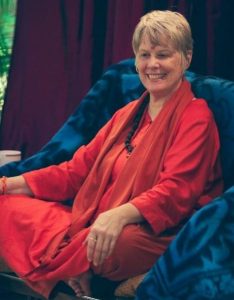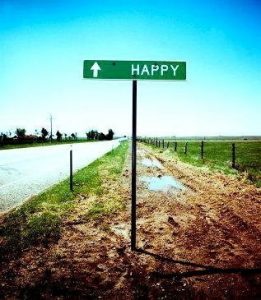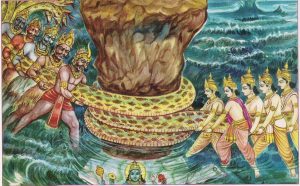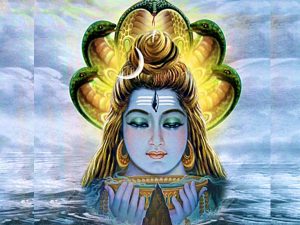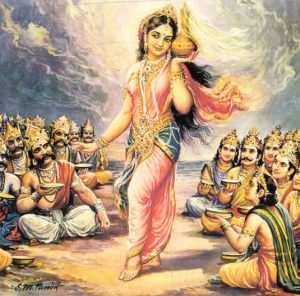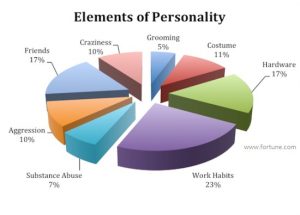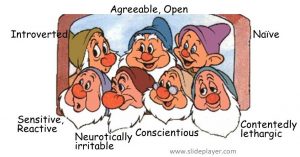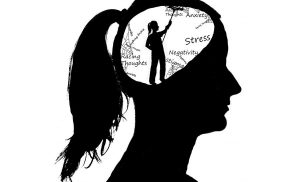I stood at the counter in the bakery this morning, pouring some milk into my mug, as the man next to me did the same. He carefully balanced a bakery box in his other hand, unwilling to let go of the four-layer carrot cake. I smiled and said, “Looks good.” He replied, quite sincerely, “Yep. I’m excited about this.”
I sat down to my breakfast and heard snatches of nearby conversations. “He said he would call me, but I’ve been waiting three days.” “It was a really good interview; I hope I get the job.” “I leave on vacation next week, I can’t wait.” Everyone is talking about the same thing — how to get happy. The whole point of buying the carrot cake, or getting the job, or going on vacation is so you will feel something on the inside. All of the outer stuff is for the purpose of creating your inner experience. Everything you do is because you hope that it will create some kind of inner feeling.
Yoga does more for you than fixing your body or relaxing away your tensions. Yoga gives you the power of creating an inner experience directly. Even if you have only done yoga once, it is easy to understand this. You go to class and do some breathing, a few poses and a guided relaxation, so you feel better. It works. It always works. It is more reliable than anything else you can ever do. No matter how you feel when you begin, you are guaranteed to feel better after you do yoga. This means you never have an excuse for feeling bad again. You can feel bad if you want to, but you have no excuse because you can improve the way you feel by doing some yoga.
The most important thing about what I am describing is the emphasis on how you feel. This is not about yoga; this is about quality of life. The medical profession has a term for it, “bio–psycho–social.” They are considering more than their patients’ physical condition; they now want to know how their patients feel. “How do you feel, physically and psychologically? How do you relate to other people? How’s your life?”
They have to ask these questions because statistics show that if you are unhappy, you will have more health complaints, visit the doctor more often and cost your health insurance company more money. If you are happy, then you don’t complain as much, regardless of your physical condition. You actually don’t hurt as much!
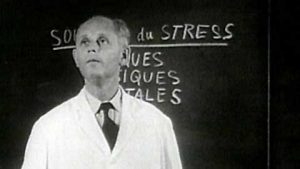 The whole thing began with Hans Selye. He researched a widespread human experience and gave it the name, “Stress Response.” He documented and described a distinct physiological response, including changes in heart rate, blood pressure, respiratory rate, changes in your digestion and many more indicators. This is now well accepted and well understood. Later Candace Pert came along and began identifying brain chemicals related to different mental and emotional states. Now the scientists have documented certain “bliss chemicals,” which your body produces when you are happy (and when you do yoga).
The whole thing began with Hans Selye. He researched a widespread human experience and gave it the name, “Stress Response.” He documented and described a distinct physiological response, including changes in heart rate, blood pressure, respiratory rate, changes in your digestion and many more indicators. This is now well accepted and well understood. Later Candace Pert came along and began identifying brain chemicals related to different mental and emotional states. Now the scientists have documented certain “bliss chemicals,” which your body produces when you are happy (and when you do yoga).
How you feel is important. In fact, it is the only thing that really matters. You will turn your life upside down in order to change the way you feel. How you feel really does matter.
Consider when you are happy or when you feel full of love — how do you treat other people? And when you are angry, anxious or sad — how do you behave? The entire world is affected by your inner experience. You spread it around, even when you don’t want to. Thus, you actually do have the power to make a real change in the world, simply by manipulating your own state. This is why I repeat so often, “Do more yoga.” You are investing in the world when you take care of yourself.
Yet yoga can take you much further than this. When you do more yoga, you feel so filled up inside that you don’t need or crave the things you wanted before. Most desires actually arise from you feeling unhappy. “If I go to the movies, then I’ll feel better.” “If I buy a new car, then I’ll be happy.” “If I move to the mountains / get a new job / find my soul–mate / have a dish of ice cream, then I’ll feel wonderful.”
Your desires arise from the feeling of inner unhappiness. All the things you do are attempts to change that inner feeling to one of happiness or joy. So, if you do yoga and feel better inside already, you may discover that you really didn’t need that dish of ice cream — because you feel wonderful already.
Yoga calls this “independent happiness.” All the things you chase after in the world create “dependent happiness,” because your feeling of happiness depends on certain external things (or people). Dependent happiness brings three inherent problems with it:
- It is temporary. Every desire that you are able to fulfill will make you feel good for only a time — unfortunately, for only a short time. Nothing that you have ever done has given you permanent happiness. You have proved this to yourself, over a period of many years. Yet you still keep trying to create happiness by fulfilling your desires. How many more years will it take before you conclude that it really doesn’t work effectively?
- It is incomplete. No matter how fulfilling a particular thing may be, it is incomplete. There are many reasons for this. It could be that you hold yourself back from whatever it is a little bit — you are not sure you can rely on it. Maybe it is because you keep the Internal Worry Department going 24/7.
- It may have side effects that are not good for you. It used to be just alcohol and drugs that were known for their damaging effects, but now many other things have been identified as harmful addictions. You can overdo so many things, even work, exercise and relationship. There are a million creative ways you can indulge in self-sabotage — all in the name of seeking happiness.
Once you discover the power of yoga, you can create an independently arising inner experience of peace, contentment and joy. You have the ability to create this, anytime you make the choice. It is a simple choice. Just do some yoga practice, and your inner experience shifts. You feel this independent happiness arising inside, and you are able to go into the activities of your life with an entirely different attitude. This may give a whole new meaning to “Happy Hour.”
 Yet, yoga offers more. As you continue your practice of yoga, your inner experiences become more profound and more exquisitely satisfying. The physical release of the hidden layers of tension begin to create a new comfort level in your body, and as you keep practicing, even more develops — you experience physical bliss, which prompts profound healings on all three levels: body, mind and emotions. In Svaroopa® yoga, it takes only a few weeks or a few months before many students begin seeing inner lights and colors. Along with the lights you can see inside, there are 12 different inner sounds that you may hear, as well as many other amazing inner experiences unfold.
Yet, yoga offers more. As you continue your practice of yoga, your inner experiences become more profound and more exquisitely satisfying. The physical release of the hidden layers of tension begin to create a new comfort level in your body, and as you keep practicing, even more develops — you experience physical bliss, which prompts profound healings on all three levels: body, mind and emotions. In Svaroopa® yoga, it takes only a few weeks or a few months before many students begin seeing inner lights and colors. Along with the lights you can see inside, there are 12 different inner sounds that you may hear, as well as many other amazing inner experiences unfold.
You can understand this subtle reality in this way. In Svaroopa® yoga, we are always working with your spine and spinal cord. Your spinal cord is the primary conduit of electrical energy in your body, the energy that runs through your nervous system. It is a specific type of electrical energy called piezo-electricity, which flows more directly once your spine is decompressed. Your brain is an extension of your spinal cord; both are made of the same gray cells. As you decompress your spine, both your spinal cord and brain are “tuned up,” much like a musical instrument. They begin to function in a whole new way.
These newly opened currents of piezo-electricity may now flow through areas of your brain related to sensory perception. As this energy flows through the visual areas of your brain, you see lights or colors on the inside. As it flows through the auditory sections, you hear inner sounds. As these currents flow though your spine, they branch out through the nerves in your whole body and create a tangible physical sensation of bliss. These are genuine experiences, and serve as landmarks along the yoga path, to show you that you are headed in the right direction — inward.
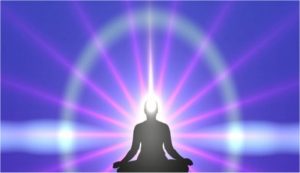 Still, the lights and other inner phenomena are not the goal. I have seen many yogis get stuck in the trap of internal sensory phenomena, because these inner experiences can be so sublime. As you continue your practice, you dive deeper within, and these sensory pleasures fade away — like leaving behind the scenery on a car trip as you draw closer to your destination.
Still, the lights and other inner phenomena are not the goal. I have seen many yogis get stuck in the trap of internal sensory phenomena, because these inner experiences can be so sublime. As you continue your practice, you dive deeper within, and these sensory pleasures fade away — like leaving behind the scenery on a car trip as you draw closer to your destination.
The culmination of your inner exploration is to discover the essence of beingness that is your own true being. It is there in every human being. It is already there inside you. It is the essence that has become everything that exists — there is only One, who is being many. You find That One inside yourself. Then you can open your eyes and look outward, and you recognize everyone and everything as another form of that inner essence. Each and every person and thing is another form of your Self — and you live your life in the inner experience of constant joy and love.
You can manipulate your own inner experience, from the simplest level to the most profound. How do you want to feel? What do you want to be dependent on? Do more yoga.
OM svaroopa svasvabhava.h namo nama.h
